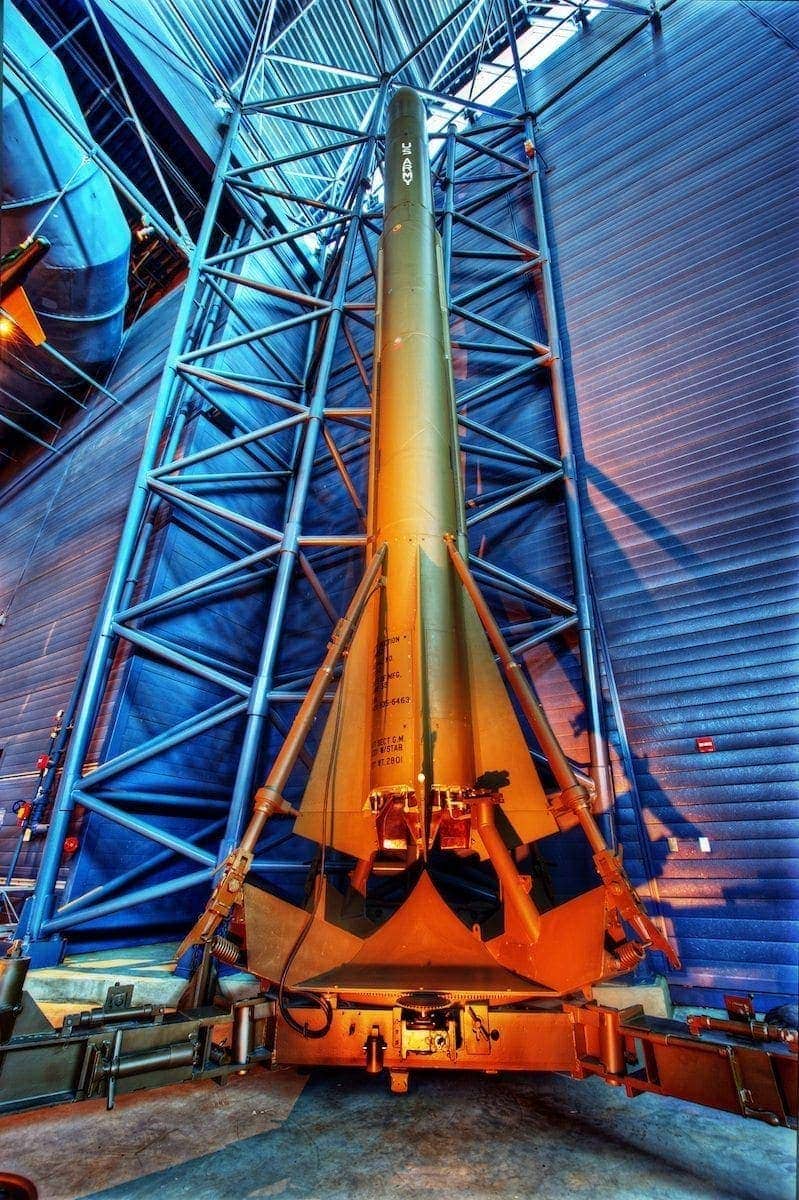Affiliate Disclosure: We earn a commission if you purchase through one of our links at no additional cost to you.
The Corporal Missile [pinit]

The other problem with this missile is that it had a reputation of not going where it was supposed to go. You could use it to lob a nuke somewhere, but it was inaccurate, so you had to hope it hit someone you didn’t like. Otherwise, you know, that would be awkward. The first versions had less than a 50% accuracy rating. Fortunately, the next generation Corporal’s improved their accuracy. That helped improve sales, too!
The Corporal missile in this photo was taken at the Udvar-Hazy National Air & Space Museum in Virginia. There’s another one a few miles from my home at the Air Force Space & Missile Museum at Cape Canaveral. Between these two sites, there are just a ton of missiles in our museums documenting the progress made from early German V2 rockets to some cruise missiles with much more sophisticated guidance systems and range.
These things were always of interest to me because it was kind of the family business. My father worked for Martin Marietta (later Lockheed Martin) producing a number of missiles and components. My brother is still there, and I spent some time out there, too. I worked on some of the final Pershing refits, Patriot missiles, and mostly on the Precision Guided Weapons that included Hellfire, Copperhead and Deadeye missiles.
Kids used to play with toy model versions of this thing that actually launched. I’m even willing to bet that the toy version of the Corporate Missile was more accurate than the real thing. Unfortunately, it would be difficult to put that to the test now. If nothing else, I’d like to see what range the toy version could reach.
Want to learn more about Travel Photography? Click below to check out more Travel Photography articles.
Travel Photography Articles







Nice photo, however it distorts what the Corporal missile really looked light.
Your commentary about the Corporal’s accuracy and reliability are very unfair. You base your comments on the admittedly miserable performance of the Type I Corporal, which was essentially an adapted experimental vehicle. The Type 1 erector was a LeTourneau log handler, an available commercial vehicle adapted for the Type I missile. Similarly, the Type I guidance system was crude compared to the Type II.
However, the Type II Corporal was a system developed on the experience of the Type I, with a missile, erector, and launcher designed for each other, and the guidance system considerably modified to solve most of the problems encountered with the Type i.
Remember that the Corporal I was the first guided missile ever put into the field by the Army. Like a baby learning to walk, it had problems. But, by the time the Corporal was phased out of service in favor of the Sergeant Missile in 1964, it was reliable and had done its job. Remember also that both types of Corporals operated on vacuum tubes, as solid state devices were just being developed — the only transisters we had were those in the little pocket radios which came out about 1957.
Personally, I was trained in 1955 as a brand new 2d Lt on the Type I system at Fort Bliss, My class of 52 2d Lts was assigned to the vacancies in the Corporal battalions, but by the time they got to the “P” names, all the slots were filed and the rest of us were assigned to anti-aircraft battalions. After two years with a Skysweeper battalion which was converted to NIKE Ajax, I was sent back to school on the Corporal II at Fort Sill and was assigned to the 530th FA Missile Battalion (CPL) at Robert E Lee Barracks in Gonsenheim, West Germany (it’s a suburb of Mainz). During my two years with the 530th (redesignated as the 1st Msl Bn (CPL), 39th Arty), I spent some 20 months as platoon leader of the 2d Platoon, Firing Battery, 530th or 1/39th. I participated in many field training exercises with the platoon and two Annual Service Practices at White Sands Missile Range, New Mexico. In all, I participated the in firing of five Type II Corporals — 3 as platoon leader and 2 as safety officer for the 1st platoon. All five missiles were sucessfully fired, and I am proud to say that one of my platoon’s missiles was the most accurate Corporal ever fired, landing within 40 feet of the desired target.
While all of us involved in the program were aware of certain shortcomings, we nonetheless knew we were pioneers in the Army’s missile program, and, should hostilities arise and the use of nuclear (or chemical) weapons were needed, the Type II Corporal would perform its duties well.
Charles A Thompson
Colonel (Field Arty), USA, Retired
Colonel Thompson,
First, thank you for your comment. I appreciate that you took the time to share your experiences and I agree with your final assessment. You were part of a ground-breaking program that naturally had bugs to shake out.
I mentioned in the article that the second version improved accuracy, something that your comments also bear out.
Although my comments were written somewhat tongue-in-cheek and seem unfair to you, I don’t think that I’m very far off. As you mentioned, the original technology was primitive compared to later systems. The record for the Type I system is about 50-50, which isn’t very reassuring when the payload is a nuclear warhead.
We’re used to seeing the results of technology like the TADS/PNVS system I worked on in the 80’s on the evening news, showing Hellfire missiles hitting seemingly impossible targets. The Corporal missiles you worked on 30 years earlier provided valuable information necessary to improve guidance and target designation to make TADS/PNVS and other systems a reality.
I’m just grateful you never truly had to put them to practice in war with a nuclear payload. Not only for the sake of their accuracy, but also for how it could have changed the world.
Thanks again for sharing your experiences. I was happy to read and get a little more insight about this piece of history.
As for the lighting, this is roughly how it appears in the Udvar-Hazy National Air and Space Museum. They have that yellow spotlight on it which sort of confuses me. Combine that with a 14-24mm wide angle lens, and it does get a bit distorted.
I was in the 367th Ord Pltn stationed in Gonsenheim at the Robert Lee Barracks in 1957 and 1958. Our missal shop was down the road from the post, and it was a big shop above the tank repair shops run by the Germans. We had Corporal missals ship in to us and we did the 5th stage maintenance on them. There were about 30 of us in the unit, with headquarters in Nancy France. I shipped back to the US in September of 1958. Was good duty and a great bunch of guys.
Hi Robert,
I apologize for the late reply. I must’ve missed this when you posted a couple of years ago. Glad to hear you have some good memories with good people.
I was the firing panel op as well as other jobs within the launching area 1957 to 64.
This was with the 47 missile Regiment Royal Artillery. Went to White Sands 1958 and on return to UK moved to Dortmund Brakel in Germany.
Firing was at Benbecula in the Scottish Hebrides, ours was the type B2 or 2B.
Drove the le tourneau a few times although not my main job which eventually turned into training men on all the equipment
My wife visited Benbecula years ago when she still lived in Scotland. I asked her how it was and she said “Overcast, wet and raining.” I think that describes most of Scotland on most days, though.
Thank you for the comment!